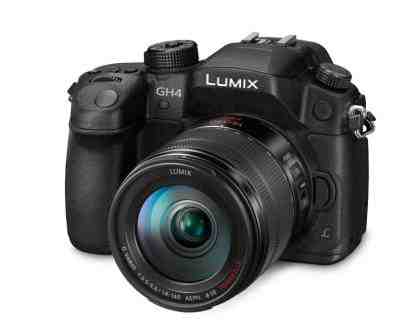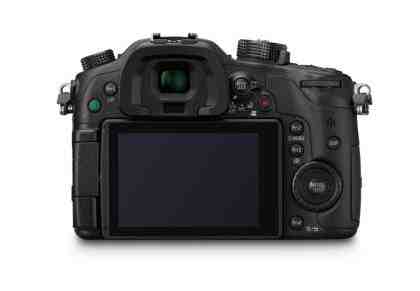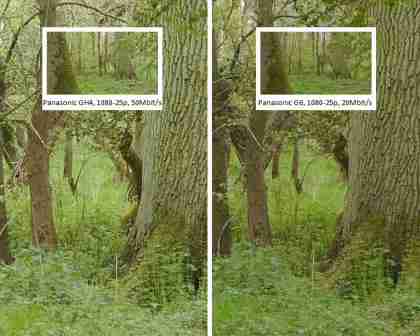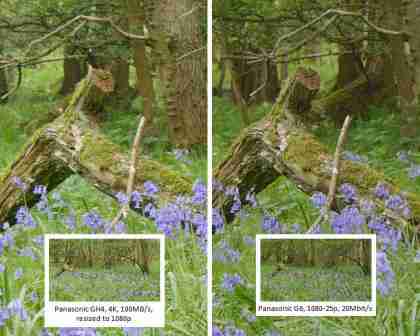Since this review was published, the Lumix GH4 has been superseded by the brilliant Lumix GH5. The newer model offers 4K video shooting at up to 60fps and 1080p at an impressive 180fps. You can read our review of the GH5 here .
If your budget can't stretch to the GH5's rather high £1,400 body-only price tag, though, the GH4 still represents one of the best-value options for budding videographers. Indeed, you can pick it up for around £500 used at retailers such as Wex and MPB , the former of which offers a 12-month guarantee on all used equipment (unless otherwise stated).
Original review continues below: Panasonic Lumix G cameras already sit a notch above other compact system cameras (CSCs) and SLRs for video quality. The GH4 is the latest addition to the range, and from the outside it's hard to distinguish from the GH3 . However, for keen videographers, this camera marks the beginning of a new chapter.

The headline new feature is the ability to shoot 4K video. 4K refers to the horizontal resolution of each frame, which is about 4,000 pixels wide. There are actually two commonly used 4K specifications. UHD is 3,840x2,160, which is equivalent to four 1080p screens arranged in a two-by-two grid. If and when UK TV channels adopt 4K, they'll probably use UHD. Then there's Cinema 4K, which has a 4,096x2,160 resolution and is widely used in cinemas. The GH4 supports both, with Cinema 4K at 24fps and UHD at 24, 25 or 30fps.
FEEL THE BENEFIT
TV manufacturers would love for everyone to upgrade to 4K, but it remains to be seen whether there's much appetite for it. However, from a videographer's point of view, the GH4's 4K capture delivers significant benefits even if the final delivery medium is 1080p.
This is partly because of a process called colour subsampling. Video compression algorithms use various tricks to reduce the amount of data, and one of these is to record the colour information (chroma) at a lower resolution than the brightness (luma). For example, the 4:2:2 subsampling format often used for AVC video means the colour data is recorded at half the resolution of the brightness data. If you've looked at a video and noticed that a bright red detail looks strangely pixelated, now you know why. By shooting at 4K, you can downsize the video to 1080p and still have each pixel captured in full colour. You may have to apply chroma subsampling again for the final 1080p distribution format, but at least you won't be applying it twice, quite possibly in different subsampling formats.

Shooting 4K for 1080p distribution also gives some detail headroom when editing. Chroma keying and other compositing tricks often take a slight toll on detail levels, so having more than enough detail to start with ensures sharp, clean edges when exporting at 1080p. If you have a 1080p export in mind, 4K can also be cropped and enlarged without compromising quality, giving some flexibility when composing shots and getting more from your lens collection. It's also particularly useful for digital stabilisation, where the picture is cropped and panned to compensate for motion in the source footage.
Lumix G cameras' video modes have always excelled for details, as the algorithms they use to resize the sensor's high-resolution output to generate a 1080p picture are superior to the competition. This requires considerable processing power, but the benefit is significant when you compare the output from Lumix G cameras that of models with simpler resizing algorithms, that result in blocky details and moiré interference. This is certainly true of the GH4, but comparing its 1080p output with that of the consumer-oriented (but still excellent) G6 , there was very little discernible difference between their detail levels.

These freeze-frames from the GH4 and G6's video output reveal there's not much improvement to detail levels in the GH4's 1080p output – click to enlarge
However, the GH4's 4K modes map a 1:1 ratio from the pixels on the sensor to the captured video, so no resizing is necessary to produce the 4K picture. This reduces the workload for the camera, but also ensures razor-sharp 4K footage. The benefit is obvious when viewed on a 4K display, but it's also plain to see after resizing UHD 4K video to 1080p.

Shooting at 4K and resizing to 1080p gives a massive boost to the fidelity of fine details – click to enlarge
Comparing the full 4K picture with the G6's 1080p output, there's no contest – click to enlarge
The 1:1 pixel mapping for 4K capture means the crop is a little tighter than it is for photos and 1080p video, but the slight loss to wide-angle shooting is a gain for telephoto.
COLOUR, NOISE AND COMPRESSION
The GH4 passed our dynamic range tests with flying colours. As a general rule, cameras' JPEG output is optimised for punchy colours, but working with the RAW file allows access to a greater range of bright and dark tones, unleashing the full potential of the sensor. Most cameras' video modes use the same colour processing engine as for JPEGs, which means a more restricted dynamic range than the sensor is capable of. That's true of the GH4 when using the Standard colour profile, but switching to Cinelike D (which is only available for videos) revealed details in shadows and highlights that were previously lost. Comparing a Cinelike D video frame with a RAW photo taken at the same exposure settings, it looks like this profile maintains the full dynamic range delivered by the sensor. Colours inevitably look a little flat as a result, but this is ideal raw footage for colour grading in video-editing software.
Heavy colour grading can increase the visibility of noise and compression artefacts, but fortunately both were extremely low. Shooting at ISO 3200 resulted in a light fizz in shadows but the video was still perfectly usable, particularly after converting 4K footage down to 1080p. 1080p videos exhibited low noise to start with.
All 4K modes capture at 100Mbit/s, and while compression artefacts were just about visible when we went looking for them in fast-moving scenes, they were pretty subtle.
4K at 100Mbit/s is actually a fairly low bit rate per pixel. There's some evidence of compression artefacts in this fast-moving scene, particularly in the blurred grass, but it's not intrusive
Various formats and bit rates are available for 1080p recording. 24Mbit/s AVCHD and 20Mbit/s MP4 cater for casual use where the priority is small file sizes and smooth playback on modest hardware. Then there's 50, 100 and 200Mbit/s AVC encoding, each with a choice of 24, 25, 30, 50 or 60fps frame rates and an MP4 or MOV wrapper. The 200Mbit/s modes employ All-Intra encoding, whereby each frame is described from scratch rather than as an update to the previous one. Meanwhile, the 100Mbit/s modes unlock a variable bit rate option, where video is captured at a choice of 13 frame rates from 2 to 96fps. The top speed delivers quarter-speed slow motion when played back at 24fps.
VIDEO FEATURES
Panasonic backs up this top-notch video performance with an impressive list of video-related functions. There's zebra pattern monitoring to warn of clipped highlights and focus peaking for confident manual focus adjustment. Luminance level and master pedestal controls provide control over the colour output to comply with common standards. Shutter and ISO speeds can be displayed in degrees and dB gain – values more familiar to video camera users. The camera can record colour bars in SMPTE, EBU and ARIB formats, and embed SMPTE timecode with Rec Run and Free Run modes for synchronisation of multiple video and sound sources.
There's a microphone input and a headphone output on 3.5mm minijack sockets, and the Micro HDMI socket can stream uncompressed 4K (4:2:2) in 8-bit or 10-bit colour. These are consumer grade socket types, so professional users will probably want to buy the DMW-YAGH interface unit (around £1,800 inc VAT). It screws into the bottom of the camera and adds a full-size HDMI output, two XLR microphone inputs with hardware volume controls and metering, four SDI sockets for uncompressed video out, an SDI timecode input and a 12V DC input.
That's clearly overkill for non-professionals, and we're disappointed that a full-size or even a Mini HDMI socket isn't included in the camera body. Micro HDMI sockets and cables are more fragile simply because of their size. There's an optional AC adapter for the camera body, which comes in two parts (part codes DMW-AC10 and DMW-DCC12), but it isn't currently on sale in the UK. Hopefully that'll be addressed soon, but we've noticed supply problems with AC adapters for other Lumix G cameras.
The camera's battery life is quoted as 500 shots, which isn't great for a camera at this price. We managed to get an impressive 202 minutes of 4K capture from a single battery, albeit in 25-minute bursts on a 16GB SDHC card (the maximum clip length is 30 minutes, regardless of card capacity). Even so, the mains adaptors are useful, as we like to be able to leave a camera plugged in and switched on all day when shooting video.
The GH4 has the same set of Wi-Fi functions as the rest of the Lumix G range. That means comprehensive remote control via iOS and Android apps, including a VGA live preview, touchscreen-controlled autofocus and full access to exposure settings including spot AE and live aperture control while recording video. It means that an iPad or Android tablet can serve as a highly effective remote control during video shoots, performing on-the-fly adjustments without any risk of shaking a tripod-mounted camera. You could even have one person pointing the camera and another adjusting settings. It's also possible to stream recorded video from the camera to the connected device. This video is re-encoded to VGA resolution to ensure smooth playback, which is extremely useful for 4K recording as most tablets can't play it.
BACK TO BASICS
Otherwise, there's not a huge amount of change compared to the GH3, but that's no bad thing. Ergonomics and controls are hard to fault, with lots of dials, switches and buttons for quick access to key settings. There's now a button to lock the mode dial to avoid accidental use. The screens' resolutions have been upgraded, with the rear 3in OLED now at one million dots and the electronic viewfinder at 2.36 million dots. The latter is also a little bigger than on the GH3, and equivalent to a 0.67x viewfinder on a full-frame camera.
This isn't an obvious choice of camera for those who aren't interested in video, but those who want a dual-purpose stills and video camera are unlikely to be disappointed. Autofocus is fast, reliable and extremely sophisticated, with the ability to track moving subjects, vary the size of the spot focus area and place it right into the corners of the frame. Pinpoint mode uses the touchscreen and a momentary magnify function to specify a very small autofocus point with clinical precision. Meanwhile, Custom Multi lets you define complex shapes to focus on by selecting and deselecting boxes arranged in a 7x7 grid. Adjusting autofocus settings is a little cumbersome via the buttons and dials when using the viewfinder, but it's extremely fast and intuitive via the touchscreen.
Continuous performance is significantly faster than on the GH3, delivering 10.5fps for 170 JPEGs or 41 RAW shots in our tests. We timed 7.1fps with continuous autofocus, and 0.3 seconds between shots in normal use. Along with the outstanding autofocus performance and a 1/8,000s maximum shutter speed, this is a superb camera for sport and wildlife photography.
The camera is a strong proposition for wedding photographers, too. Unlike the quiet modes on SLRs, the GH4's Silent Mode is genuinely silent, as it doesn't use the mechanical shutter. The downside is that in this mode images exhibit the rolling shutter effect, whereby the geometry of fast-moving subjects is slightly skewed because the top of the frame is captured earlier than the bottom. However, that's unlikely to be a problem in situations that call for silent operation.
The GH4's image quality can't match that of full-frame SLRs costing a few hundred pounds more, and it's also slightly behind the best APS-C cameras such as the Nikon D7100 and Canon EOS 70D . The 16-megapixel sensor falls a little short for details compared to the Canon's 20 and the Nikon's 24 megapixels, and with its smaller sensor it exhibited slightly higher noise levels at ISO 3200 and above. We'd be happy to shoot at ISO 1600 for critical use, though, and ISO 3200 and 6400 are good enough for distribution at small resolutions. There's a strong collection of Micro Four Lenses available, including the sumptuous 42.5mm f/1.2 stabilised lens we had the pleasure of testing alongside the GH4. Very wide apertures such as this mean there's less call for fast ISO speeds.
The JPEG engine handles dense and subtle details well at the base ISO 200 setting
With a bit of help from the 42.5mm prime lens, details are as sharp as we could possibly hope for from a 16-megapixel sensor - click to enlarge
The 42.5mm lens excels in low light with its f/1.2 maximum aperture, delivering a tight depth of field and keeping the ISO speed down. Noise reduction artefacts are visible at ISO 1000 but they're not too intrusive - click to enlarge
There's not too much visible grain in this ISO 3200 shot but the hair texture has been smoothed over by noise reduction - click to enlarge
A NEW DAWN FOR VIDEO?
We were really looking forward to getting our hands on this camera, but it still surpassed our expectations, particularly in the benefits it delivers for 1080p video production. It's the obvious choice for anyone remotely serious about video production, delivering big benefits now and even bigger rewards if and when 4K catches on.
It'll be interesting to see how Panasonic's competitors respond. We already know about the Sony A7s with its ability to stream 4K video from its HDMI output to an external recorder, but that makes it a relatively niche product. It probably won't be long before Sony delivers a direct rival for the GH4.
The other manufacturer to watch is Canon. It has been making some big strides in video in both professional and amateur enthusiast markets. If it can deliver a camera with the EOS 70D's superb autofocus along with 4K capture with a 1:1 pixel readout, then that would really shakes things up. For now, though, the GH4 is untroubled by the competition.
Basic Specifications | |
|---|---|
| Rating | ***** |
| CCD effective megapixels | 16.0 megapixels |
| CCD size | 17.3x13mm |
| Viewfinder | electronic (2.36 million dots) |
| Viewfinder magnification, coverage | 1.34x, 100% |
| LCD screen size | 3.0in |
| LCD screen resolution | 1,036,000 pixels |
| Articulated screen | Yes |
| Live view | Yes |
| Optical zoom | N/A |
| Zoom 35mm equivalent | N/A |
| Image stabilisation | Available in lenses |
| Maximum image resolution | 4608x3456 |
| File formats | JPEG, RAW; AVCHD, MP4 (AVC), QuickTime (AVC) |
Physical | |
| Memory slot | SDXC |
| Mermory supplied | none |
| Battery type | Li-ion |
| Battery Life (tested) | 500 shots |
| Connectivity | USB, AV, micro HDMI, 3.5mm microphone, 3.5mm headphone, 2.5mm wired remote, PC sync, Wi-Fi, NFC |
| Body material | magnesium alloy |
| Lens mount | Micro Four Thirds |
| Focal length multiplier | 2.0x |
| Kit lens model name | N/A |
| Accessories | USB cable, neck strap |
| Weight | 560g |
| Size | 95x144x84mm |
Buying Information | |
| Warranty | one year RTB |
| Price | £1,299 |
| Supplier | http://www.wexphotographic.com |
| Details | www.panasonic.co.uk |
Camera Controls | |
| Exposure modes | program, shutter priority, aperture priority, manual |
| Shutter speed | 60 to 1/8,000 seconds |
| Aperture range | N/A |
| ISO range (at full resolution) | 200 to 25,600 |
| Exposure compensation | +/-5 EV |
| White balance | auto, 5 presets with fine tuning, 4 manual presets, Kelvin |
| Additional image controls | contrast, saturation, sharpness, hue, noise reduction, Highlight/Shadow, i.Dynamic, shading compensation, colour space |
| Manual focus | Yes |
| Closest macro focus | N/A |
| Auto-focus modes | multi, custom multi, flexible spot, face detect, tracking, pinpoint |
| Metering modes | multi, centre-weighted, centre, face detect |
| Flash | auto, forced, suppressed, slow synchro, rear curtain, red-eye reduction |
| Drive modes | single, continuous, self-timer, AE bracket, WB bracket, HDR |






Leave a Reply